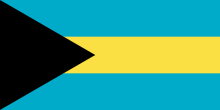BAHAMAS
 Situated south-east of Florida, the Bahamian archipelago (Bahamas : Baja Mar distorted by the English) is composed of over 700 islands or islets. The main islands are : New Providence (33 km long), the island where is the capital, Nassau, and live 60% of the population ; Gran Bahama located in 177 km in the south-west of New Providence ; The Biminis, Abacos and Eleuthera which form the North Islands ; Long Island and The Exuma which are the South Islands.
Situated south-east of Florida, the Bahamian archipelago (Bahamas : Baja Mar distorted by the English) is composed of over 700 islands or islets. The main islands are : New Providence (33 km long), the island where is the capital, Nassau, and live 60% of the population ; Gran Bahama located in 177 km in the south-west of New Providence ; The Biminis, Abacos and Eleuthera which form the North Islands ; Long Island and The Exuma which are the South Islands.
The topography is extremely flat or ondulated and covered with bush. The Bahamas’ area is 13 950 sq km. The Bahamas’ highest point is Mont Alvernia (62m high), situated on Cat Island. The long white or pinkish beaches are lined with a turquoise sea ; they are numerous and represent 3 540 km. The Bahamas have the third barrier of coral reefs of the world.
The Bahamas have 22 national parks and reserves which include the coral reef. Among other things, they are in charge of the protection of the endangered species like the Bahamian parrot (the national bird), the green turtles and the world’s largest colony of West Indian flamingos that live in Crooked Island, Long Cay and Great Inagua.The archipelago has a varied wildlife. Indeed, there are also racoons, horses, donkeys, iguanas that can be 1 or 2 m long. The Bahamas are a paradise for the bird-watchers because of its 300 species of bird.
With its 7 000 sq km of coral reefs, several fishes can be seen in the sea for example, sharks, stingrays, kingfishers, bonitos, dolphins…
Tourism, banking and fishing are the main economic activities of the country.
When the Europeans arrived, 40 000 Lucayans – an Arawak tribe – lived in the Bahamas ; they would have colonized the archipelago around the 9th century AD. However, potteries, tools, drawings and bones showed that these islands were populated between 300 and 400 AD. According to the archaeologists, this people would has come from Cuba.
The Bahamas were the first lands that Christopher Columbus and his Spanish fleet saw when they arrived in the New World in 1492. Exhausted by the trip, then they shouted : “Land! Land!”. The Spaniards did not delay enslaving the Amerindians by sending them to the island of Hispaniola (now Haiti and the Dominican Republic) then, they left the archipelago. In 1648, English puritans, the Eleutheran Adventurers, who had been expelled from Bermuda, settled in the région. In the 17th century, the Bahamas became British. The stories of Spanish treasures enticed pirates and adventurers such as Francis Drake, Walter Raleigh, Henry Jennings and Edward Teach (the famous Blackbeard). The latter did not hesitate to found, in 1666, a lawless city in New Providence Island with taverns and brothels frequented by bandits. In the end, in 1718, the British authorities succeeded in establishing order and an administration in the archipelago. Governor Woodes Rogers took advantage of the opportunity to chase away all the pirates while “Blackbeard” was sailing.
In 1760, the former governor of Massachusetts, William Shirley, realized roadworks (streets, sewers…) in New Providence. The archipelago became officially a British colony, in 1783. The American Revolution caused the arrival of many loyalist refugees ; their fortunes boosted the economy of the capital, Nassau. Some of them tried to recreate on the islands cotton plantations farmed by African slaves. Because the soil was not suited to this growing, these landowners went bankrupt. In 1807, England banned the trade slaves then abolished slavery in 1834.
During the Prohibition (1919-1933), the Bahamas supplied illicitly the United States with alcohol. Tourism started to develop rapidly from the 1920s with the creation of an American well-to-do class.
After the Cuban Revolution, from 1961, the rich Americans left Havana to come and have fun to Nassau which became, at that time, a fashionable place.
Then, the Black middle-class aspired to share and lead the political power to protect its poor population.
On July 10, 1973, the Islands of The Bahamas became officialy independent. The archipelago belongs to the Commonwealth.
Area : 13 950 sq km (5 386 sq miles)
Population : 392 000 inhabitants
Capital : Nassau (New Providence Island)
Language : English
Currency : Bahamian Dollar (BS$)
People : Bahamians
